Ontario's Environmental Assessment Process: A Detailed Review
VerifiedAdded on 2023/06/12
|8
|3524
|340
Report
AI Summary
This report provides a detailed analysis of the Environmental Assessment (EA) process in Ontario, examining its evolution since the 1970s and its administration under the Environmental Assessment Act. It evaluates the strategies implemented by the Ontario EA process, focusing on both comprehensive and streamlined environmental reviews. The report also explores the substitution of the Federal EA process under the Canadian Environmental Assessment Act 2012 (CEAA 2012), contrasting the strengths and limitations of federal and Ontario EA processes. Key modifications to the Act, including time durations for evaluation and public review requirements, are discussed. Furthermore, the analysis covers regulatory exclusions, public considerations, and the role of the Environmental Commissioner in ensuring the EA program remains viable and relevant, addressing policy gaps and bureaucratic inconsistencies. The report concludes by highlighting the importance of cumulative environmental assessments and the need for consistent regulations to address the environmental challenges facing Ontario.
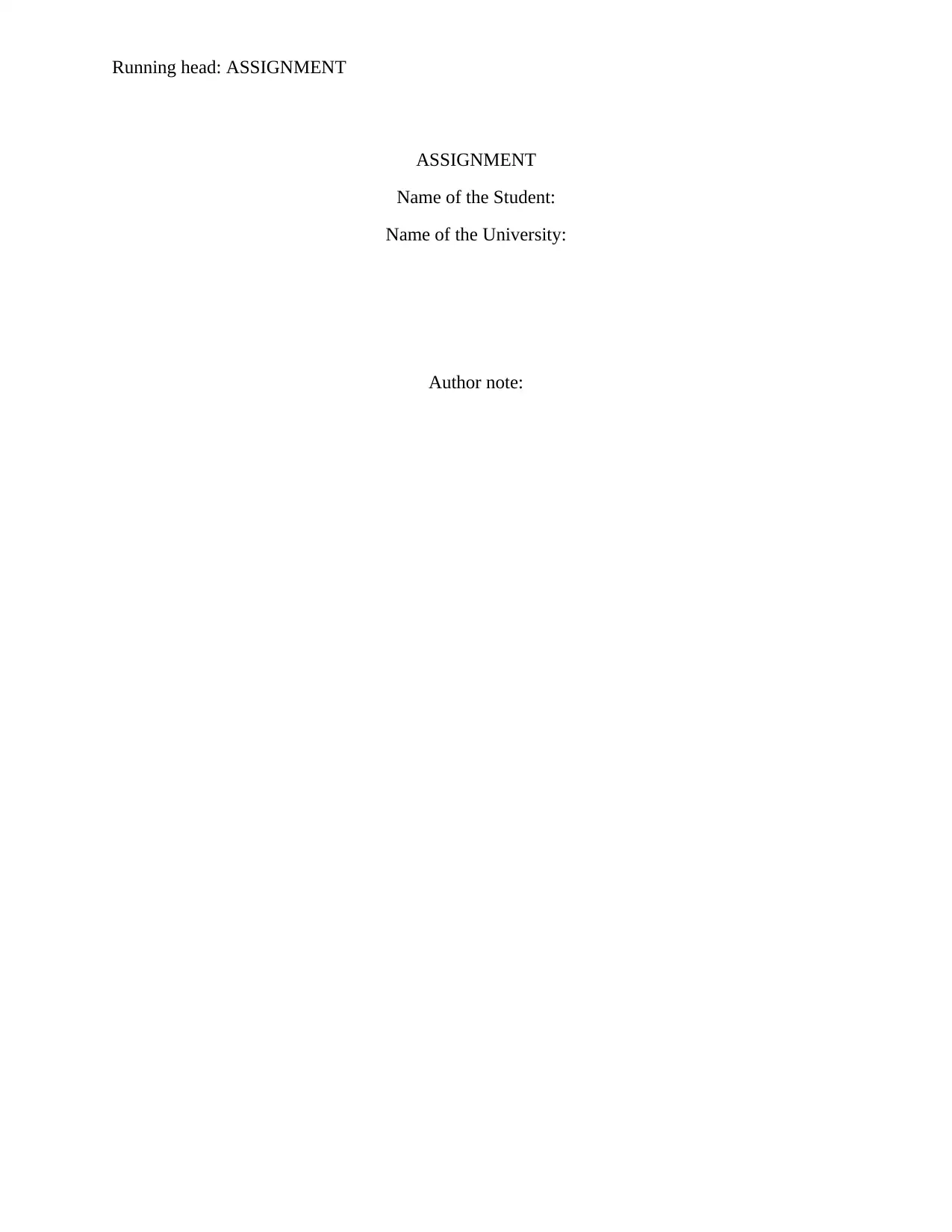
Running head: ASSIGNMENT
ASSIGNMENT
Name of the Student:
Name of the University:
Author note:
ASSIGNMENT
Name of the Student:
Name of the University:
Author note:
Paraphrase This Document
Need a fresh take? Get an instant paraphrase of this document with our AI Paraphraser
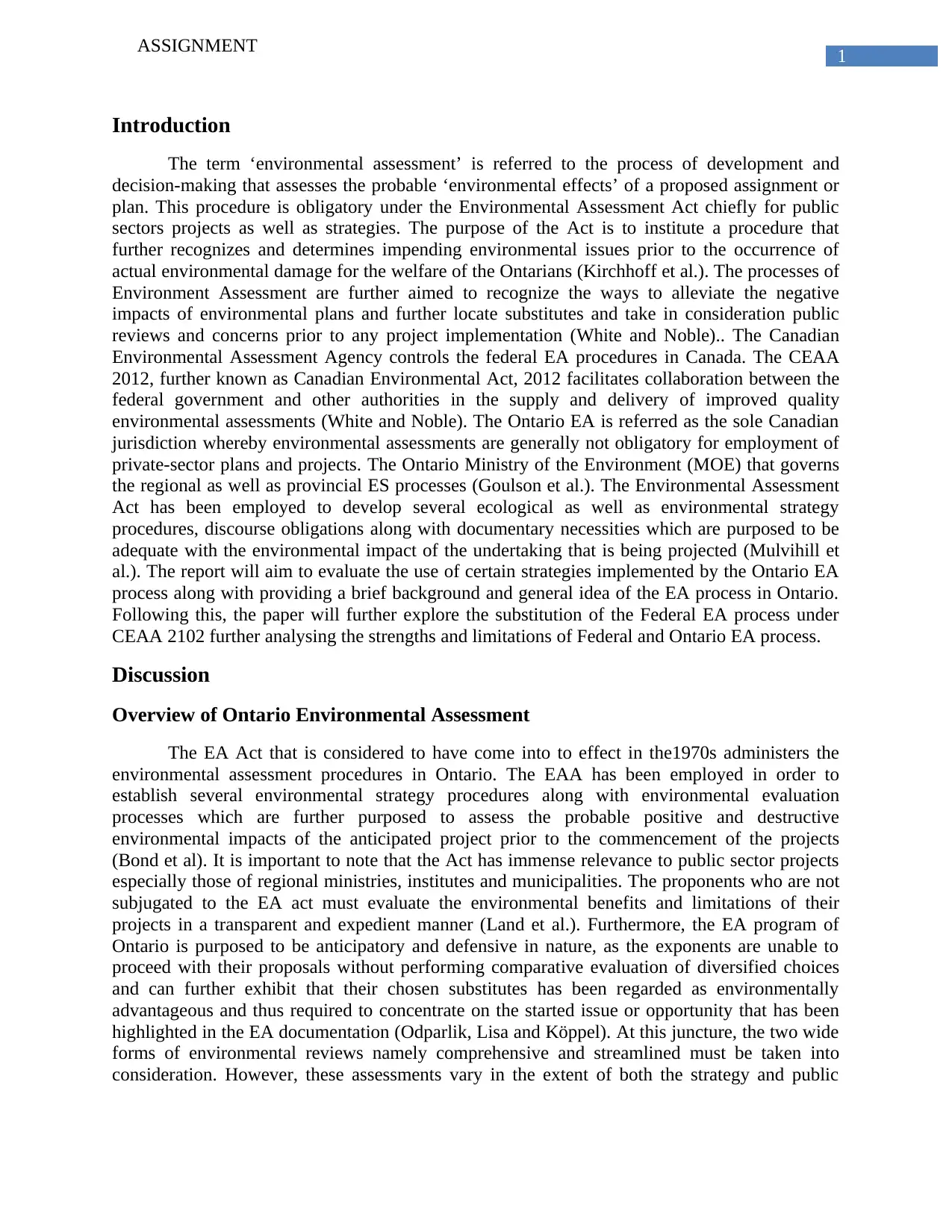
1
ASSIGNMENT
Introduction
The term ‘environmental assessment’ is referred to the process of development and
decision-making that assesses the probable ‘environmental effects’ of a proposed assignment or
plan. This procedure is obligatory under the Environmental Assessment Act chiefly for public
sectors projects as well as strategies. The purpose of the Act is to institute a procedure that
further recognizes and determines impending environmental issues prior to the occurrence of
actual environmental damage for the welfare of the Ontarians (Kirchhoff et al.). The processes of
Environment Assessment are further aimed to recognize the ways to alleviate the negative
impacts of environmental plans and further locate substitutes and take in consideration public
reviews and concerns prior to any project implementation (White and Noble).. The Canadian
Environmental Assessment Agency controls the federal EA procedures in Canada. The CEAA
2012, further known as Canadian Environmental Act, 2012 facilitates collaboration between the
federal government and other authorities in the supply and delivery of improved quality
environmental assessments (White and Noble). The Ontario EA is referred as the sole Canadian
jurisdiction whereby environmental assessments are generally not obligatory for employment of
private-sector plans and projects. The Ontario Ministry of the Environment (MOE) that governs
the regional as well as provincial ES processes (Goulson et al.). The Environmental Assessment
Act has been employed to develop several ecological as well as environmental strategy
procedures, discourse obligations along with documentary necessities which are purposed to be
adequate with the environmental impact of the undertaking that is being projected (Mulvihill et
al.). The report will aim to evaluate the use of certain strategies implemented by the Ontario EA
process along with providing a brief background and general idea of the EA process in Ontario.
Following this, the paper will further explore the substitution of the Federal EA process under
CEAA 2102 further analysing the strengths and limitations of Federal and Ontario EA process.
Discussion
Overview of Ontario Environmental Assessment
The EA Act that is considered to have come into to effect in the1970s administers the
environmental assessment procedures in Ontario. The EAA has been employed in order to
establish several environmental strategy procedures along with environmental evaluation
processes which are further purposed to assess the probable positive and destructive
environmental impacts of the anticipated project prior to the commencement of the projects
(Bond et al). It is important to note that the Act has immense relevance to public sector projects
especially those of regional ministries, institutes and municipalities. The proponents who are not
subjugated to the EA act must evaluate the environmental benefits and limitations of their
projects in a transparent and expedient manner (Land et al.). Furthermore, the EA program of
Ontario is purposed to be anticipatory and defensive in nature, as the exponents are unable to
proceed with their proposals without performing comparative evaluation of diversified choices
and can further exhibit that their chosen substitutes has been regarded as environmentally
advantageous and thus required to concentrate on the started issue or opportunity that has been
highlighted in the EA documentation (Odparlik, Lisa and Köppel). At this juncture, the two wide
forms of environmental reviews namely comprehensive and streamlined must be taken into
consideration. However, these assessments vary in the extent of both the strategy and public
ASSIGNMENT
Introduction
The term ‘environmental assessment’ is referred to the process of development and
decision-making that assesses the probable ‘environmental effects’ of a proposed assignment or
plan. This procedure is obligatory under the Environmental Assessment Act chiefly for public
sectors projects as well as strategies. The purpose of the Act is to institute a procedure that
further recognizes and determines impending environmental issues prior to the occurrence of
actual environmental damage for the welfare of the Ontarians (Kirchhoff et al.). The processes of
Environment Assessment are further aimed to recognize the ways to alleviate the negative
impacts of environmental plans and further locate substitutes and take in consideration public
reviews and concerns prior to any project implementation (White and Noble).. The Canadian
Environmental Assessment Agency controls the federal EA procedures in Canada. The CEAA
2012, further known as Canadian Environmental Act, 2012 facilitates collaboration between the
federal government and other authorities in the supply and delivery of improved quality
environmental assessments (White and Noble). The Ontario EA is referred as the sole Canadian
jurisdiction whereby environmental assessments are generally not obligatory for employment of
private-sector plans and projects. The Ontario Ministry of the Environment (MOE) that governs
the regional as well as provincial ES processes (Goulson et al.). The Environmental Assessment
Act has been employed to develop several ecological as well as environmental strategy
procedures, discourse obligations along with documentary necessities which are purposed to be
adequate with the environmental impact of the undertaking that is being projected (Mulvihill et
al.). The report will aim to evaluate the use of certain strategies implemented by the Ontario EA
process along with providing a brief background and general idea of the EA process in Ontario.
Following this, the paper will further explore the substitution of the Federal EA process under
CEAA 2102 further analysing the strengths and limitations of Federal and Ontario EA process.
Discussion
Overview of Ontario Environmental Assessment
The EA Act that is considered to have come into to effect in the1970s administers the
environmental assessment procedures in Ontario. The EAA has been employed in order to
establish several environmental strategy procedures along with environmental evaluation
processes which are further purposed to assess the probable positive and destructive
environmental impacts of the anticipated project prior to the commencement of the projects
(Bond et al). It is important to note that the Act has immense relevance to public sector projects
especially those of regional ministries, institutes and municipalities. The proponents who are not
subjugated to the EA act must evaluate the environmental benefits and limitations of their
projects in a transparent and expedient manner (Land et al.). Furthermore, the EA program of
Ontario is purposed to be anticipatory and defensive in nature, as the exponents are unable to
proceed with their proposals without performing comparative evaluation of diversified choices
and can further exhibit that their chosen substitutes has been regarded as environmentally
advantageous and thus required to concentrate on the started issue or opportunity that has been
highlighted in the EA documentation (Odparlik, Lisa and Köppel). At this juncture, the two wide
forms of environmental reviews namely comprehensive and streamlined must be taken into
consideration. However, these assessments vary in the extent of both the strategy and public
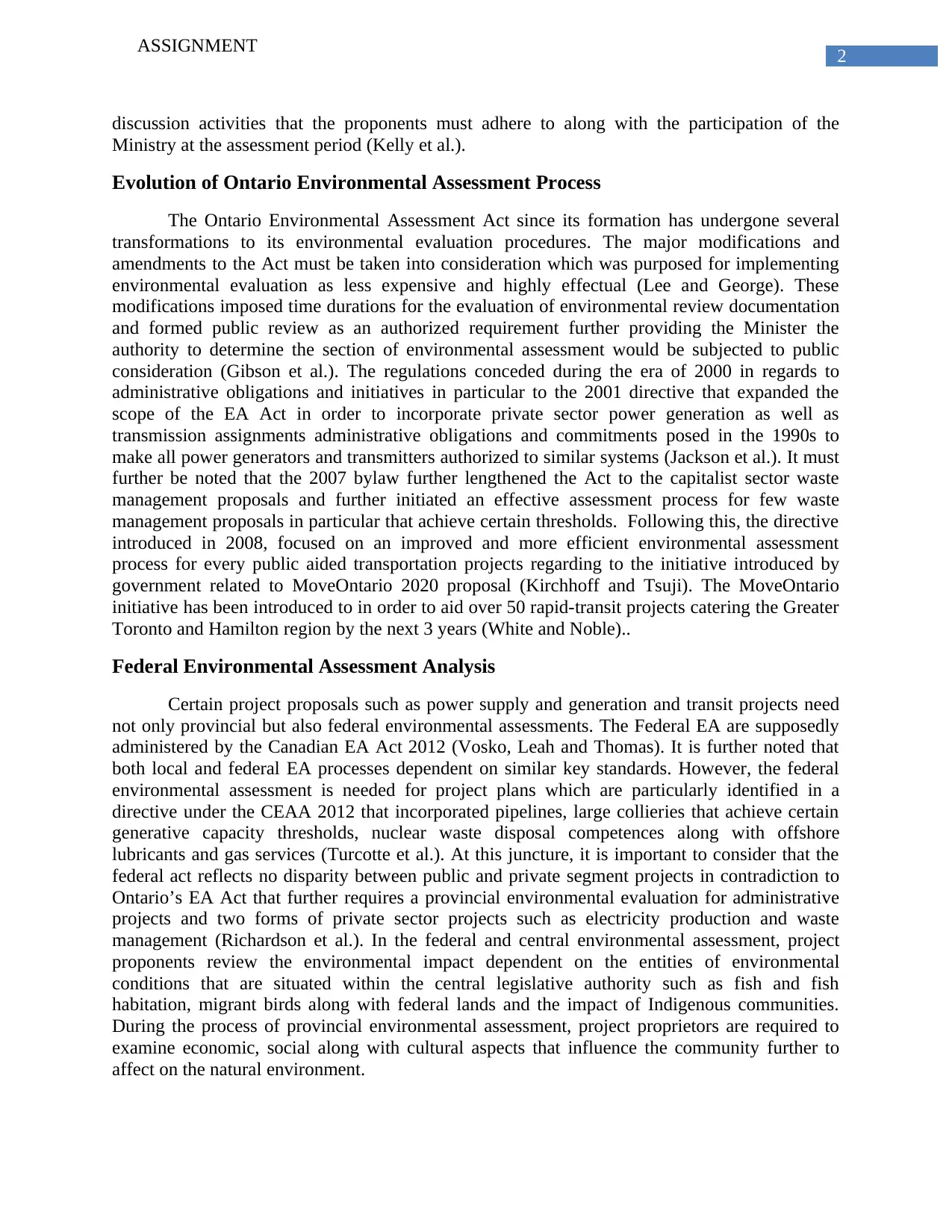
2
ASSIGNMENT
discussion activities that the proponents must adhere to along with the participation of the
Ministry at the assessment period (Kelly et al.).
Evolution of Ontario Environmental Assessment Process
The Ontario Environmental Assessment Act since its formation has undergone several
transformations to its environmental evaluation procedures. The major modifications and
amendments to the Act must be taken into consideration which was purposed for implementing
environmental evaluation as less expensive and highly effectual (Lee and George). These
modifications imposed time durations for the evaluation of environmental review documentation
and formed public review as an authorized requirement further providing the Minister the
authority to determine the section of environmental assessment would be subjected to public
consideration (Gibson et al.). The regulations conceded during the era of 2000 in regards to
administrative obligations and initiatives in particular to the 2001 directive that expanded the
scope of the EA Act in order to incorporate private sector power generation as well as
transmission assignments administrative obligations and commitments posed in the 1990s to
make all power generators and transmitters authorized to similar systems (Jackson et al.). It must
further be noted that the 2007 bylaw further lengthened the Act to the capitalist sector waste
management proposals and further initiated an effective assessment process for few waste
management proposals in particular that achieve certain thresholds. Following this, the directive
introduced in 2008, focused on an improved and more efficient environmental assessment
process for every public aided transportation projects regarding to the initiative introduced by
government related to MoveOntario 2020 proposal (Kirchhoff and Tsuji). The MoveOntario
initiative has been introduced to in order to aid over 50 rapid-transit projects catering the Greater
Toronto and Hamilton region by the next 3 years (White and Noble)..
Federal Environmental Assessment Analysis
Certain project proposals such as power supply and generation and transit projects need
not only provincial but also federal environmental assessments. The Federal EA are supposedly
administered by the Canadian EA Act 2012 (Vosko, Leah and Thomas). It is further noted that
both local and federal EA processes dependent on similar key standards. However, the federal
environmental assessment is needed for project plans which are particularly identified in a
directive under the CEAA 2012 that incorporated pipelines, large collieries that achieve certain
generative capacity thresholds, nuclear waste disposal competences along with offshore
lubricants and gas services (Turcotte et al.). At this juncture, it is important to consider that the
federal act reflects no disparity between public and private segment projects in contradiction to
Ontario’s EA Act that further requires a provincial environmental evaluation for administrative
projects and two forms of private sector projects such as electricity production and waste
management (Richardson et al.). In the federal and central environmental assessment, project
proponents review the environmental impact dependent on the entities of environmental
conditions that are situated within the central legislative authority such as fish and fish
habitation, migrant birds along with federal lands and the impact of Indigenous communities.
During the process of provincial environmental assessment, project proprietors are required to
examine economic, social along with cultural aspects that influence the community further to
affect on the natural environment.
ASSIGNMENT
discussion activities that the proponents must adhere to along with the participation of the
Ministry at the assessment period (Kelly et al.).
Evolution of Ontario Environmental Assessment Process
The Ontario Environmental Assessment Act since its formation has undergone several
transformations to its environmental evaluation procedures. The major modifications and
amendments to the Act must be taken into consideration which was purposed for implementing
environmental evaluation as less expensive and highly effectual (Lee and George). These
modifications imposed time durations for the evaluation of environmental review documentation
and formed public review as an authorized requirement further providing the Minister the
authority to determine the section of environmental assessment would be subjected to public
consideration (Gibson et al.). The regulations conceded during the era of 2000 in regards to
administrative obligations and initiatives in particular to the 2001 directive that expanded the
scope of the EA Act in order to incorporate private sector power generation as well as
transmission assignments administrative obligations and commitments posed in the 1990s to
make all power generators and transmitters authorized to similar systems (Jackson et al.). It must
further be noted that the 2007 bylaw further lengthened the Act to the capitalist sector waste
management proposals and further initiated an effective assessment process for few waste
management proposals in particular that achieve certain thresholds. Following this, the directive
introduced in 2008, focused on an improved and more efficient environmental assessment
process for every public aided transportation projects regarding to the initiative introduced by
government related to MoveOntario 2020 proposal (Kirchhoff and Tsuji). The MoveOntario
initiative has been introduced to in order to aid over 50 rapid-transit projects catering the Greater
Toronto and Hamilton region by the next 3 years (White and Noble)..
Federal Environmental Assessment Analysis
Certain project proposals such as power supply and generation and transit projects need
not only provincial but also federal environmental assessments. The Federal EA are supposedly
administered by the Canadian EA Act 2012 (Vosko, Leah and Thomas). It is further noted that
both local and federal EA processes dependent on similar key standards. However, the federal
environmental assessment is needed for project plans which are particularly identified in a
directive under the CEAA 2012 that incorporated pipelines, large collieries that achieve certain
generative capacity thresholds, nuclear waste disposal competences along with offshore
lubricants and gas services (Turcotte et al.). At this juncture, it is important to consider that the
federal act reflects no disparity between public and private segment projects in contradiction to
Ontario’s EA Act that further requires a provincial environmental evaluation for administrative
projects and two forms of private sector projects such as electricity production and waste
management (Richardson et al.). In the federal and central environmental assessment, project
proponents review the environmental impact dependent on the entities of environmental
conditions that are situated within the central legislative authority such as fish and fish
habitation, migrant birds along with federal lands and the impact of Indigenous communities.
During the process of provincial environmental assessment, project proprietors are required to
examine economic, social along with cultural aspects that influence the community further to
affect on the natural environment.
⊘ This is a preview!⊘
Do you want full access?
Subscribe today to unlock all pages.

Trusted by 1+ million students worldwide
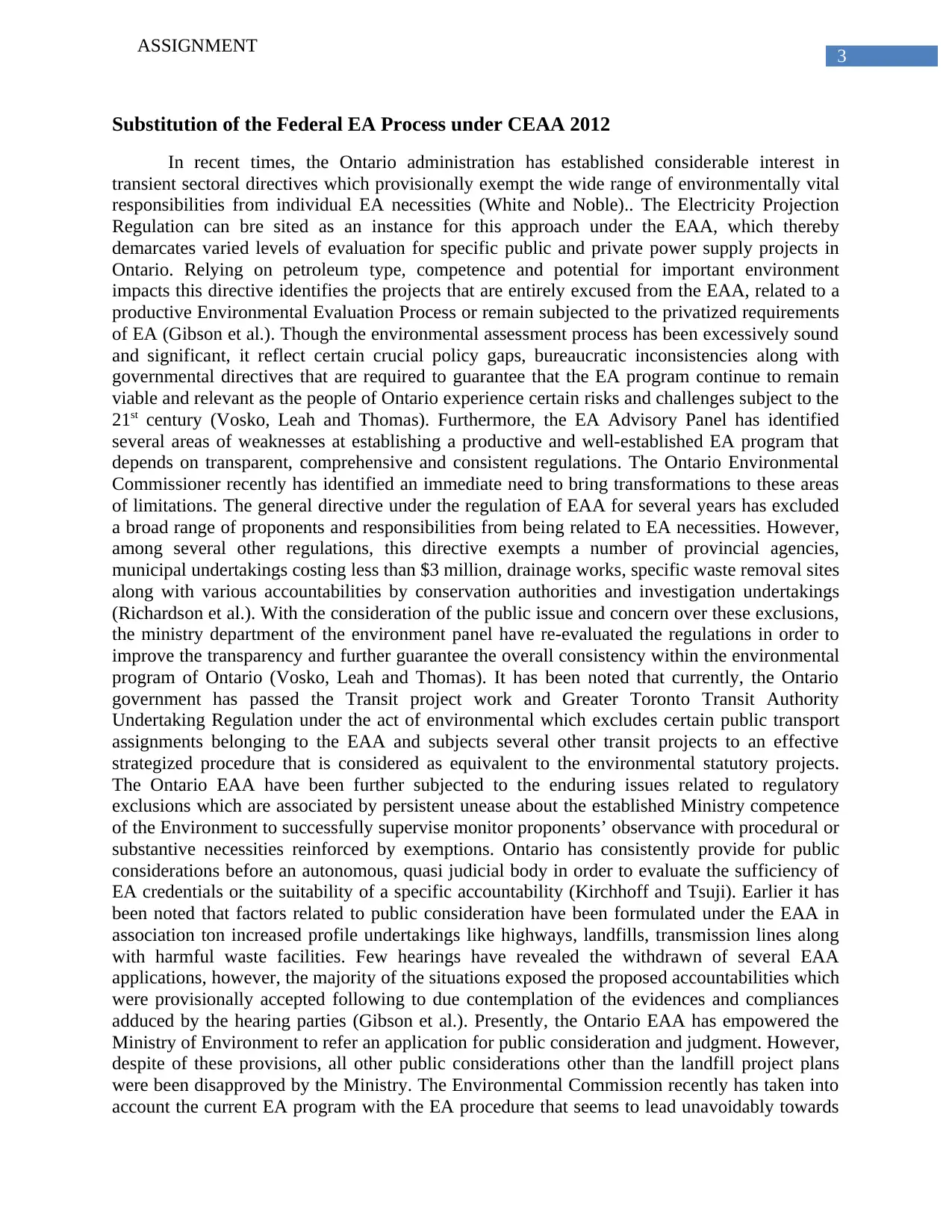
3
ASSIGNMENT
Substitution of the Federal EA Process under CEAA 2012
In recent times, the Ontario administration has established considerable interest in
transient sectoral directives which provisionally exempt the wide range of environmentally vital
responsibilities from individual EA necessities (White and Noble).. The Electricity Projection
Regulation can bre sited as an instance for this approach under the EAA, which thereby
demarcates varied levels of evaluation for specific public and private power supply projects in
Ontario. Relying on petroleum type, competence and potential for important environment
impacts this directive identifies the projects that are entirely excused from the EAA, related to a
productive Environmental Evaluation Process or remain subjected to the privatized requirements
of EA (Gibson et al.). Though the environmental assessment process has been excessively sound
and significant, it reflect certain crucial policy gaps, bureaucratic inconsistencies along with
governmental directives that are required to guarantee that the EA program continue to remain
viable and relevant as the people of Ontario experience certain risks and challenges subject to the
21st century (Vosko, Leah and Thomas). Furthermore, the EA Advisory Panel has identified
several areas of weaknesses at establishing a productive and well-established EA program that
depends on transparent, comprehensive and consistent regulations. The Ontario Environmental
Commissioner recently has identified an immediate need to bring transformations to these areas
of limitations. The general directive under the regulation of EAA for several years has excluded
a broad range of proponents and responsibilities from being related to EA necessities. However,
among several other regulations, this directive exempts a number of provincial agencies,
municipal undertakings costing less than $3 million, drainage works, specific waste removal sites
along with various accountabilities by conservation authorities and investigation undertakings
(Richardson et al.). With the consideration of the public issue and concern over these exclusions,
the ministry department of the environment panel have re-evaluated the regulations in order to
improve the transparency and further guarantee the overall consistency within the environmental
program of Ontario (Vosko, Leah and Thomas). It has been noted that currently, the Ontario
government has passed the Transit project work and Greater Toronto Transit Authority
Undertaking Regulation under the act of environmental which excludes certain public transport
assignments belonging to the EAA and subjects several other transit projects to an effective
strategized procedure that is considered as equivalent to the environmental statutory projects.
The Ontario EAA have been further subjected to the enduring issues related to regulatory
exclusions which are associated by persistent unease about the established Ministry competence
of the Environment to successfully supervise monitor proponents’ observance with procedural or
substantive necessities reinforced by exemptions. Ontario has consistently provide for public
considerations before an autonomous, quasi judicial body in order to evaluate the sufficiency of
EA credentials or the suitability of a specific accountability (Kirchhoff and Tsuji). Earlier it has
been noted that factors related to public consideration have been formulated under the EAA in
association ton increased profile undertakings like highways, landfills, transmission lines along
with harmful waste facilities. Few hearings have revealed the withdrawn of several EAA
applications, however, the majority of the situations exposed the proposed accountabilities which
were provisionally accepted following to due contemplation of the evidences and compliances
adduced by the hearing parties (Gibson et al.). Presently, the Ontario EAA has empowered the
Ministry of Environment to refer an application for public consideration and judgment. However,
despite of these provisions, all other public considerations other than the landfill project plans
were been disapproved by the Ministry. The Environmental Commission recently has taken into
account the current EA program with the EA procedure that seems to lead unavoidably towards
ASSIGNMENT
Substitution of the Federal EA Process under CEAA 2012
In recent times, the Ontario administration has established considerable interest in
transient sectoral directives which provisionally exempt the wide range of environmentally vital
responsibilities from individual EA necessities (White and Noble).. The Electricity Projection
Regulation can bre sited as an instance for this approach under the EAA, which thereby
demarcates varied levels of evaluation for specific public and private power supply projects in
Ontario. Relying on petroleum type, competence and potential for important environment
impacts this directive identifies the projects that are entirely excused from the EAA, related to a
productive Environmental Evaluation Process or remain subjected to the privatized requirements
of EA (Gibson et al.). Though the environmental assessment process has been excessively sound
and significant, it reflect certain crucial policy gaps, bureaucratic inconsistencies along with
governmental directives that are required to guarantee that the EA program continue to remain
viable and relevant as the people of Ontario experience certain risks and challenges subject to the
21st century (Vosko, Leah and Thomas). Furthermore, the EA Advisory Panel has identified
several areas of weaknesses at establishing a productive and well-established EA program that
depends on transparent, comprehensive and consistent regulations. The Ontario Environmental
Commissioner recently has identified an immediate need to bring transformations to these areas
of limitations. The general directive under the regulation of EAA for several years has excluded
a broad range of proponents and responsibilities from being related to EA necessities. However,
among several other regulations, this directive exempts a number of provincial agencies,
municipal undertakings costing less than $3 million, drainage works, specific waste removal sites
along with various accountabilities by conservation authorities and investigation undertakings
(Richardson et al.). With the consideration of the public issue and concern over these exclusions,
the ministry department of the environment panel have re-evaluated the regulations in order to
improve the transparency and further guarantee the overall consistency within the environmental
program of Ontario (Vosko, Leah and Thomas). It has been noted that currently, the Ontario
government has passed the Transit project work and Greater Toronto Transit Authority
Undertaking Regulation under the act of environmental which excludes certain public transport
assignments belonging to the EAA and subjects several other transit projects to an effective
strategized procedure that is considered as equivalent to the environmental statutory projects.
The Ontario EAA have been further subjected to the enduring issues related to regulatory
exclusions which are associated by persistent unease about the established Ministry competence
of the Environment to successfully supervise monitor proponents’ observance with procedural or
substantive necessities reinforced by exemptions. Ontario has consistently provide for public
considerations before an autonomous, quasi judicial body in order to evaluate the sufficiency of
EA credentials or the suitability of a specific accountability (Kirchhoff and Tsuji). Earlier it has
been noted that factors related to public consideration have been formulated under the EAA in
association ton increased profile undertakings like highways, landfills, transmission lines along
with harmful waste facilities. Few hearings have revealed the withdrawn of several EAA
applications, however, the majority of the situations exposed the proposed accountabilities which
were provisionally accepted following to due contemplation of the evidences and compliances
adduced by the hearing parties (Gibson et al.). Presently, the Ontario EAA has empowered the
Ministry of Environment to refer an application for public consideration and judgment. However,
despite of these provisions, all other public considerations other than the landfill project plans
were been disapproved by the Ministry. The Environmental Commission recently has taken into
account the current EA program with the EA procedure that seems to lead unavoidably towards
Paraphrase This Document
Need a fresh take? Get an instant paraphrase of this document with our AI Paraphraser
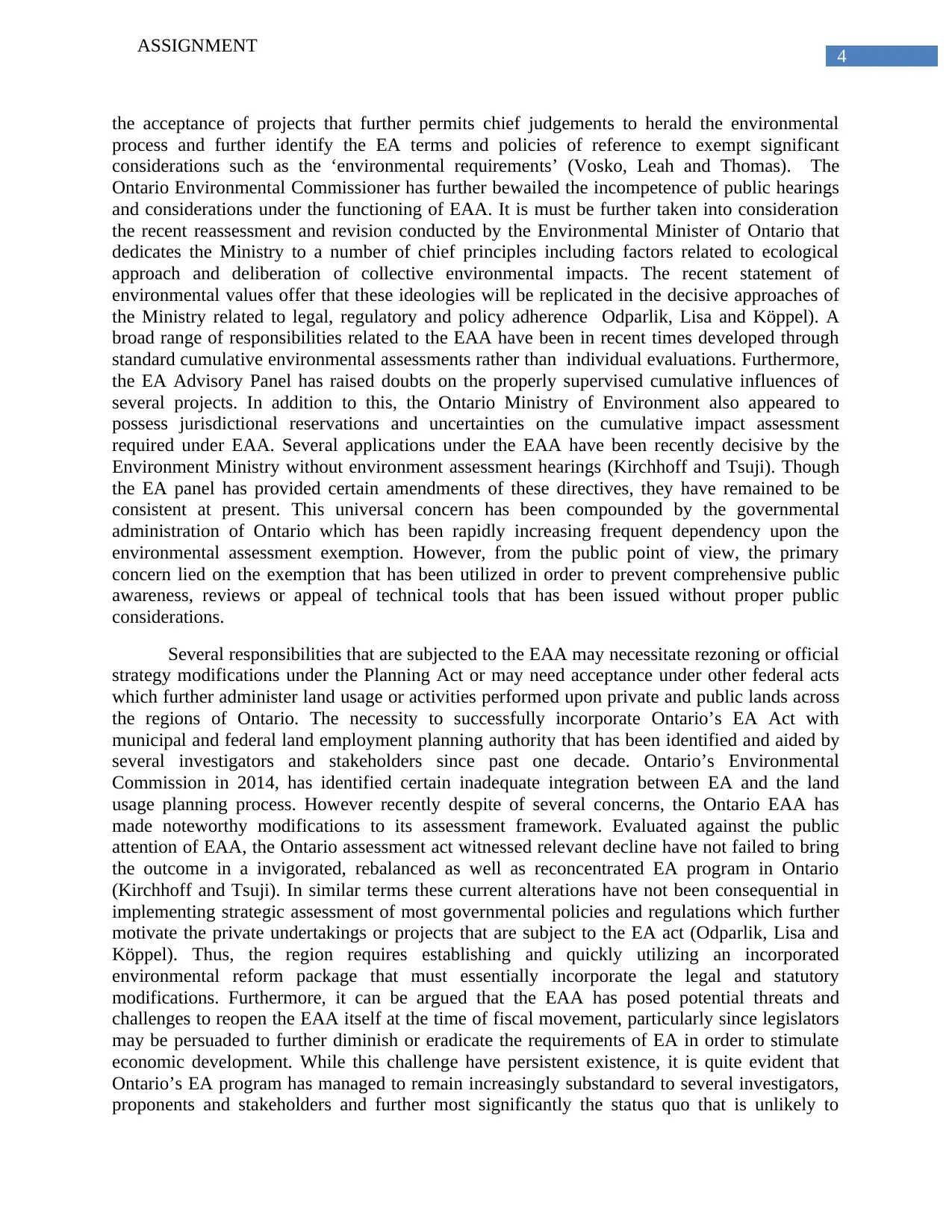
4
ASSIGNMENT
the acceptance of projects that further permits chief judgements to herald the environmental
process and further identify the EA terms and policies of reference to exempt significant
considerations such as the ‘environmental requirements’ (Vosko, Leah and Thomas). The
Ontario Environmental Commissioner has further bewailed the incompetence of public hearings
and considerations under the functioning of EAA. It is must be further taken into consideration
the recent reassessment and revision conducted by the Environmental Minister of Ontario that
dedicates the Ministry to a number of chief principles including factors related to ecological
approach and deliberation of collective environmental impacts. The recent statement of
environmental values offer that these ideologies will be replicated in the decisive approaches of
the Ministry related to legal, regulatory and policy adherence Odparlik, Lisa and Köppel). A
broad range of responsibilities related to the EAA have been in recent times developed through
standard cumulative environmental assessments rather than individual evaluations. Furthermore,
the EA Advisory Panel has raised doubts on the properly supervised cumulative influences of
several projects. In addition to this, the Ontario Ministry of Environment also appeared to
possess jurisdictional reservations and uncertainties on the cumulative impact assessment
required under EAA. Several applications under the EAA have been recently decisive by the
Environment Ministry without environment assessment hearings (Kirchhoff and Tsuji). Though
the EA panel has provided certain amendments of these directives, they have remained to be
consistent at present. This universal concern has been compounded by the governmental
administration of Ontario which has been rapidly increasing frequent dependency upon the
environmental assessment exemption. However, from the public point of view, the primary
concern lied on the exemption that has been utilized in order to prevent comprehensive public
awareness, reviews or appeal of technical tools that has been issued without proper public
considerations.
Several responsibilities that are subjected to the EAA may necessitate rezoning or official
strategy modifications under the Planning Act or may need acceptance under other federal acts
which further administer land usage or activities performed upon private and public lands across
the regions of Ontario. The necessity to successfully incorporate Ontario’s EA Act with
municipal and federal land employment planning authority that has been identified and aided by
several investigators and stakeholders since past one decade. Ontario’s Environmental
Commission in 2014, has identified certain inadequate integration between EA and the land
usage planning process. However recently despite of several concerns, the Ontario EAA has
made noteworthy modifications to its assessment framework. Evaluated against the public
attention of EAA, the Ontario assessment act witnessed relevant decline have not failed to bring
the outcome in a invigorated, rebalanced as well as reconcentrated EA program in Ontario
(Kirchhoff and Tsuji). In similar terms these current alterations have not been consequential in
implementing strategic assessment of most governmental policies and regulations which further
motivate the private undertakings or projects that are subject to the EA act (Odparlik, Lisa and
Köppel). Thus, the region requires establishing and quickly utilizing an incorporated
environmental reform package that must essentially incorporate the legal and statutory
modifications. Furthermore, it can be argued that the EAA has posed potential threats and
challenges to reopen the EAA itself at the time of fiscal movement, particularly since legislators
may be persuaded to further diminish or eradicate the requirements of EA in order to stimulate
economic development. While this challenge have persistent existence, it is quite evident that
Ontario’s EA program has managed to remain increasingly substandard to several investigators,
proponents and stakeholders and further most significantly the status quo that is unlikely to
ASSIGNMENT
the acceptance of projects that further permits chief judgements to herald the environmental
process and further identify the EA terms and policies of reference to exempt significant
considerations such as the ‘environmental requirements’ (Vosko, Leah and Thomas). The
Ontario Environmental Commissioner has further bewailed the incompetence of public hearings
and considerations under the functioning of EAA. It is must be further taken into consideration
the recent reassessment and revision conducted by the Environmental Minister of Ontario that
dedicates the Ministry to a number of chief principles including factors related to ecological
approach and deliberation of collective environmental impacts. The recent statement of
environmental values offer that these ideologies will be replicated in the decisive approaches of
the Ministry related to legal, regulatory and policy adherence Odparlik, Lisa and Köppel). A
broad range of responsibilities related to the EAA have been in recent times developed through
standard cumulative environmental assessments rather than individual evaluations. Furthermore,
the EA Advisory Panel has raised doubts on the properly supervised cumulative influences of
several projects. In addition to this, the Ontario Ministry of Environment also appeared to
possess jurisdictional reservations and uncertainties on the cumulative impact assessment
required under EAA. Several applications under the EAA have been recently decisive by the
Environment Ministry without environment assessment hearings (Kirchhoff and Tsuji). Though
the EA panel has provided certain amendments of these directives, they have remained to be
consistent at present. This universal concern has been compounded by the governmental
administration of Ontario which has been rapidly increasing frequent dependency upon the
environmental assessment exemption. However, from the public point of view, the primary
concern lied on the exemption that has been utilized in order to prevent comprehensive public
awareness, reviews or appeal of technical tools that has been issued without proper public
considerations.
Several responsibilities that are subjected to the EAA may necessitate rezoning or official
strategy modifications under the Planning Act or may need acceptance under other federal acts
which further administer land usage or activities performed upon private and public lands across
the regions of Ontario. The necessity to successfully incorporate Ontario’s EA Act with
municipal and federal land employment planning authority that has been identified and aided by
several investigators and stakeholders since past one decade. Ontario’s Environmental
Commission in 2014, has identified certain inadequate integration between EA and the land
usage planning process. However recently despite of several concerns, the Ontario EAA has
made noteworthy modifications to its assessment framework. Evaluated against the public
attention of EAA, the Ontario assessment act witnessed relevant decline have not failed to bring
the outcome in a invigorated, rebalanced as well as reconcentrated EA program in Ontario
(Kirchhoff and Tsuji). In similar terms these current alterations have not been consequential in
implementing strategic assessment of most governmental policies and regulations which further
motivate the private undertakings or projects that are subject to the EA act (Odparlik, Lisa and
Köppel). Thus, the region requires establishing and quickly utilizing an incorporated
environmental reform package that must essentially incorporate the legal and statutory
modifications. Furthermore, it can be argued that the EAA has posed potential threats and
challenges to reopen the EAA itself at the time of fiscal movement, particularly since legislators
may be persuaded to further diminish or eradicate the requirements of EA in order to stimulate
economic development. While this challenge have persistent existence, it is quite evident that
Ontario’s EA program has managed to remain increasingly substandard to several investigators,
proponents and stakeholders and further most significantly the status quo that is unlikely to
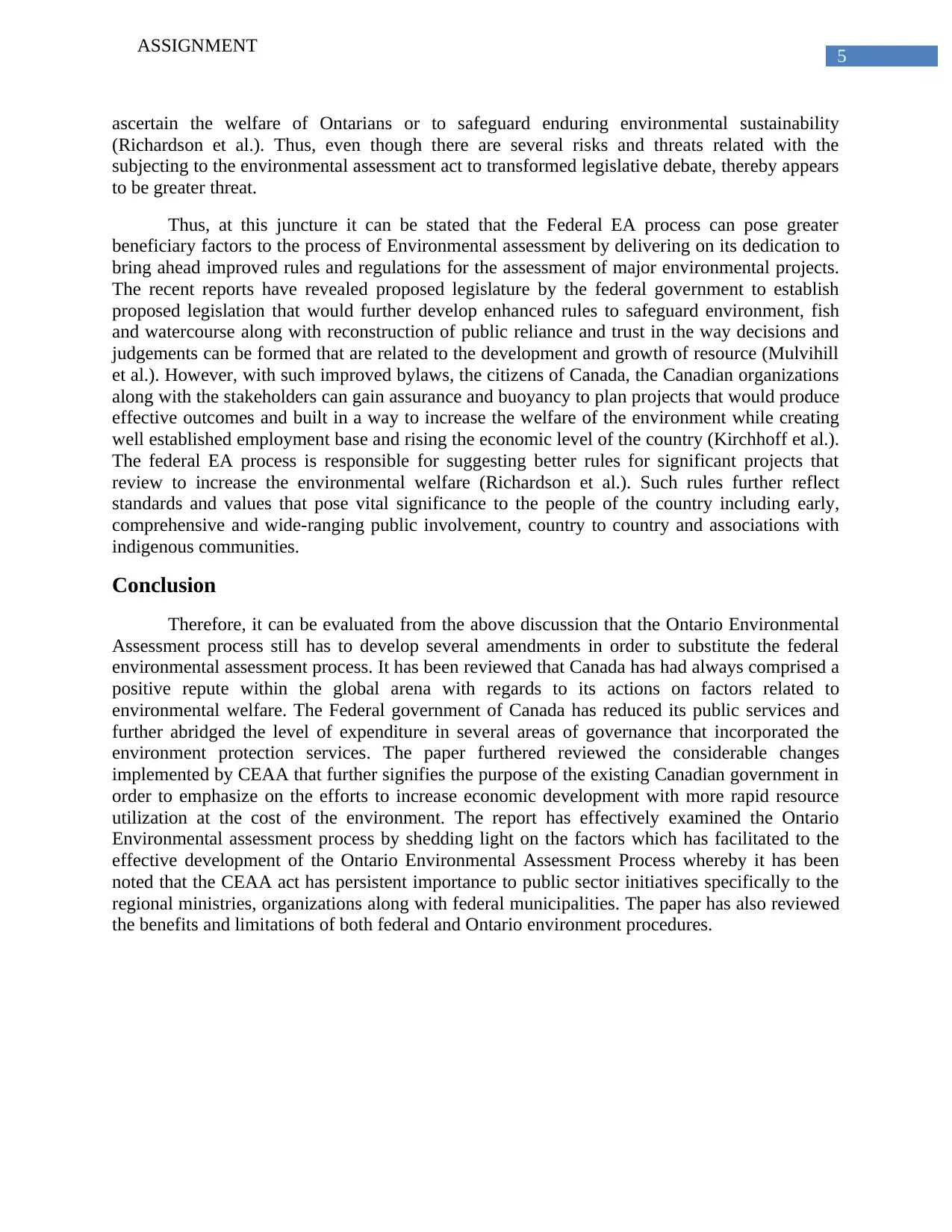
5
ASSIGNMENT
ascertain the welfare of Ontarians or to safeguard enduring environmental sustainability
(Richardson et al.). Thus, even though there are several risks and threats related with the
subjecting to the environmental assessment act to transformed legislative debate, thereby appears
to be greater threat.
Thus, at this juncture it can be stated that the Federal EA process can pose greater
beneficiary factors to the process of Environmental assessment by delivering on its dedication to
bring ahead improved rules and regulations for the assessment of major environmental projects.
The recent reports have revealed proposed legislature by the federal government to establish
proposed legislation that would further develop enhanced rules to safeguard environment, fish
and watercourse along with reconstruction of public reliance and trust in the way decisions and
judgements can be formed that are related to the development and growth of resource (Mulvihill
et al.). However, with such improved bylaws, the citizens of Canada, the Canadian organizations
along with the stakeholders can gain assurance and buoyancy to plan projects that would produce
effective outcomes and built in a way to increase the welfare of the environment while creating
well established employment base and rising the economic level of the country (Kirchhoff et al.).
The federal EA process is responsible for suggesting better rules for significant projects that
review to increase the environmental welfare (Richardson et al.). Such rules further reflect
standards and values that pose vital significance to the people of the country including early,
comprehensive and wide-ranging public involvement, country to country and associations with
indigenous communities.
Conclusion
Therefore, it can be evaluated from the above discussion that the Ontario Environmental
Assessment process still has to develop several amendments in order to substitute the federal
environmental assessment process. It has been reviewed that Canada has had always comprised a
positive repute within the global arena with regards to its actions on factors related to
environmental welfare. The Federal government of Canada has reduced its public services and
further abridged the level of expenditure in several areas of governance that incorporated the
environment protection services. The paper furthered reviewed the considerable changes
implemented by CEAA that further signifies the purpose of the existing Canadian government in
order to emphasize on the efforts to increase economic development with more rapid resource
utilization at the cost of the environment. The report has effectively examined the Ontario
Environmental assessment process by shedding light on the factors which has facilitated to the
effective development of the Ontario Environmental Assessment Process whereby it has been
noted that the CEAA act has persistent importance to public sector initiatives specifically to the
regional ministries, organizations along with federal municipalities. The paper has also reviewed
the benefits and limitations of both federal and Ontario environment procedures.
ASSIGNMENT
ascertain the welfare of Ontarians or to safeguard enduring environmental sustainability
(Richardson et al.). Thus, even though there are several risks and threats related with the
subjecting to the environmental assessment act to transformed legislative debate, thereby appears
to be greater threat.
Thus, at this juncture it can be stated that the Federal EA process can pose greater
beneficiary factors to the process of Environmental assessment by delivering on its dedication to
bring ahead improved rules and regulations for the assessment of major environmental projects.
The recent reports have revealed proposed legislature by the federal government to establish
proposed legislation that would further develop enhanced rules to safeguard environment, fish
and watercourse along with reconstruction of public reliance and trust in the way decisions and
judgements can be formed that are related to the development and growth of resource (Mulvihill
et al.). However, with such improved bylaws, the citizens of Canada, the Canadian organizations
along with the stakeholders can gain assurance and buoyancy to plan projects that would produce
effective outcomes and built in a way to increase the welfare of the environment while creating
well established employment base and rising the economic level of the country (Kirchhoff et al.).
The federal EA process is responsible for suggesting better rules for significant projects that
review to increase the environmental welfare (Richardson et al.). Such rules further reflect
standards and values that pose vital significance to the people of the country including early,
comprehensive and wide-ranging public involvement, country to country and associations with
indigenous communities.
Conclusion
Therefore, it can be evaluated from the above discussion that the Ontario Environmental
Assessment process still has to develop several amendments in order to substitute the federal
environmental assessment process. It has been reviewed that Canada has had always comprised a
positive repute within the global arena with regards to its actions on factors related to
environmental welfare. The Federal government of Canada has reduced its public services and
further abridged the level of expenditure in several areas of governance that incorporated the
environment protection services. The paper furthered reviewed the considerable changes
implemented by CEAA that further signifies the purpose of the existing Canadian government in
order to emphasize on the efforts to increase economic development with more rapid resource
utilization at the cost of the environment. The report has effectively examined the Ontario
Environmental assessment process by shedding light on the factors which has facilitated to the
effective development of the Ontario Environmental Assessment Process whereby it has been
noted that the CEAA act has persistent importance to public sector initiatives specifically to the
regional ministries, organizations along with federal municipalities. The paper has also reviewed
the benefits and limitations of both federal and Ontario environment procedures.
⊘ This is a preview!⊘
Do you want full access?
Subscribe today to unlock all pages.

Trusted by 1+ million students worldwide
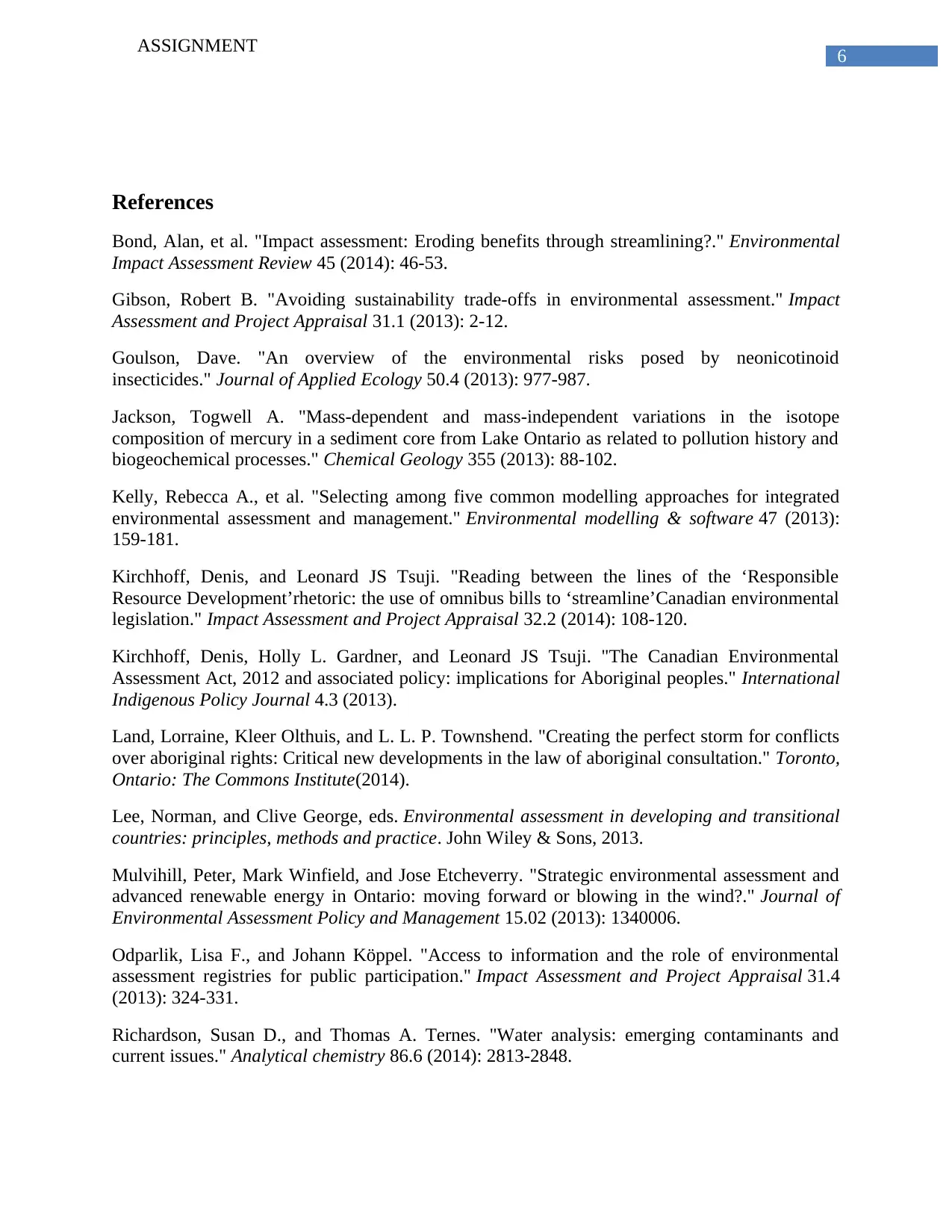
6
ASSIGNMENT
References
Bond, Alan, et al. "Impact assessment: Eroding benefits through streamlining?." Environmental
Impact Assessment Review 45 (2014): 46-53.
Gibson, Robert B. "Avoiding sustainability trade-offs in environmental assessment." Impact
Assessment and Project Appraisal 31.1 (2013): 2-12.
Goulson, Dave. "An overview of the environmental risks posed by neonicotinoid
insecticides." Journal of Applied Ecology 50.4 (2013): 977-987.
Jackson, Togwell A. "Mass-dependent and mass-independent variations in the isotope
composition of mercury in a sediment core from Lake Ontario as related to pollution history and
biogeochemical processes." Chemical Geology 355 (2013): 88-102.
Kelly, Rebecca A., et al. "Selecting among five common modelling approaches for integrated
environmental assessment and management." Environmental modelling & software 47 (2013):
159-181.
Kirchhoff, Denis, and Leonard JS Tsuji. "Reading between the lines of the ‘Responsible
Resource Development’rhetoric: the use of omnibus bills to ‘streamline’Canadian environmental
legislation." Impact Assessment and Project Appraisal 32.2 (2014): 108-120.
Kirchhoff, Denis, Holly L. Gardner, and Leonard JS Tsuji. "The Canadian Environmental
Assessment Act, 2012 and associated policy: implications for Aboriginal peoples." International
Indigenous Policy Journal 4.3 (2013).
Land, Lorraine, Kleer Olthuis, and L. L. P. Townshend. "Creating the perfect storm for conflicts
over aboriginal rights: Critical new developments in the law of aboriginal consultation." Toronto,
Ontario: The Commons Institute(2014).
Lee, Norman, and Clive George, eds. Environmental assessment in developing and transitional
countries: principles, methods and practice. John Wiley & Sons, 2013.
Mulvihill, Peter, Mark Winfield, and Jose Etcheverry. "Strategic environmental assessment and
advanced renewable energy in Ontario: moving forward or blowing in the wind?." Journal of
Environmental Assessment Policy and Management 15.02 (2013): 1340006.
Odparlik, Lisa F., and Johann Köppel. "Access to information and the role of environmental
assessment registries for public participation." Impact Assessment and Project Appraisal 31.4
(2013): 324-331.
Richardson, Susan D., and Thomas A. Ternes. "Water analysis: emerging contaminants and
current issues." Analytical chemistry 86.6 (2014): 2813-2848.
ASSIGNMENT
References
Bond, Alan, et al. "Impact assessment: Eroding benefits through streamlining?." Environmental
Impact Assessment Review 45 (2014): 46-53.
Gibson, Robert B. "Avoiding sustainability trade-offs in environmental assessment." Impact
Assessment and Project Appraisal 31.1 (2013): 2-12.
Goulson, Dave. "An overview of the environmental risks posed by neonicotinoid
insecticides." Journal of Applied Ecology 50.4 (2013): 977-987.
Jackson, Togwell A. "Mass-dependent and mass-independent variations in the isotope
composition of mercury in a sediment core from Lake Ontario as related to pollution history and
biogeochemical processes." Chemical Geology 355 (2013): 88-102.
Kelly, Rebecca A., et al. "Selecting among five common modelling approaches for integrated
environmental assessment and management." Environmental modelling & software 47 (2013):
159-181.
Kirchhoff, Denis, and Leonard JS Tsuji. "Reading between the lines of the ‘Responsible
Resource Development’rhetoric: the use of omnibus bills to ‘streamline’Canadian environmental
legislation." Impact Assessment and Project Appraisal 32.2 (2014): 108-120.
Kirchhoff, Denis, Holly L. Gardner, and Leonard JS Tsuji. "The Canadian Environmental
Assessment Act, 2012 and associated policy: implications for Aboriginal peoples." International
Indigenous Policy Journal 4.3 (2013).
Land, Lorraine, Kleer Olthuis, and L. L. P. Townshend. "Creating the perfect storm for conflicts
over aboriginal rights: Critical new developments in the law of aboriginal consultation." Toronto,
Ontario: The Commons Institute(2014).
Lee, Norman, and Clive George, eds. Environmental assessment in developing and transitional
countries: principles, methods and practice. John Wiley & Sons, 2013.
Mulvihill, Peter, Mark Winfield, and Jose Etcheverry. "Strategic environmental assessment and
advanced renewable energy in Ontario: moving forward or blowing in the wind?." Journal of
Environmental Assessment Policy and Management 15.02 (2013): 1340006.
Odparlik, Lisa F., and Johann Köppel. "Access to information and the role of environmental
assessment registries for public participation." Impact Assessment and Project Appraisal 31.4
(2013): 324-331.
Richardson, Susan D., and Thomas A. Ternes. "Water analysis: emerging contaminants and
current issues." Analytical chemistry 86.6 (2014): 2813-2848.
Paraphrase This Document
Need a fresh take? Get an instant paraphrase of this document with our AI Paraphraser
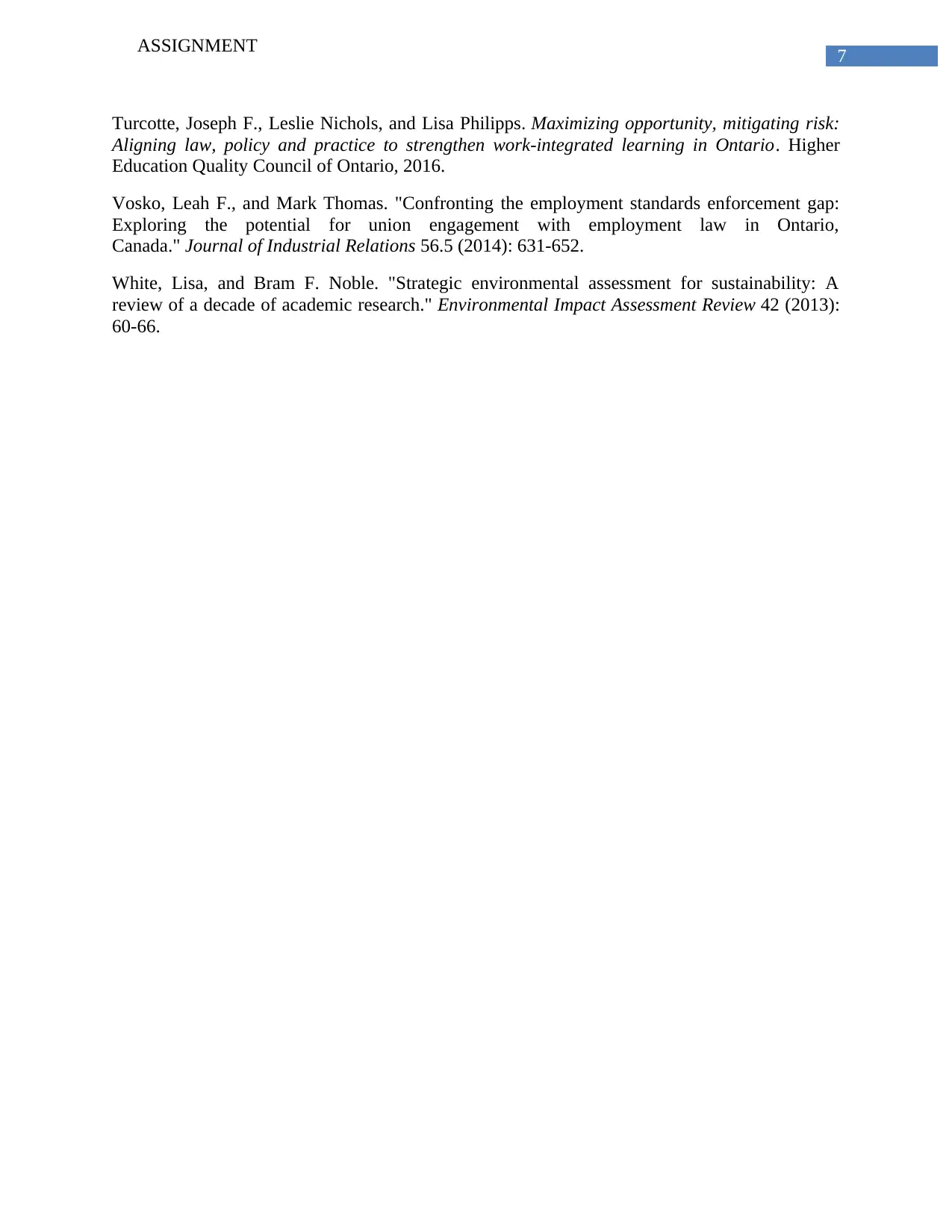
7
ASSIGNMENT
Turcotte, Joseph F., Leslie Nichols, and Lisa Philipps. Maximizing opportunity, mitigating risk:
Aligning law, policy and practice to strengthen work-integrated learning in Ontario. Higher
Education Quality Council of Ontario, 2016.
Vosko, Leah F., and Mark Thomas. "Confronting the employment standards enforcement gap:
Exploring the potential for union engagement with employment law in Ontario,
Canada." Journal of Industrial Relations 56.5 (2014): 631-652.
White, Lisa, and Bram F. Noble. "Strategic environmental assessment for sustainability: A
review of a decade of academic research." Environmental Impact Assessment Review 42 (2013):
60-66.
ASSIGNMENT
Turcotte, Joseph F., Leslie Nichols, and Lisa Philipps. Maximizing opportunity, mitigating risk:
Aligning law, policy and practice to strengthen work-integrated learning in Ontario. Higher
Education Quality Council of Ontario, 2016.
Vosko, Leah F., and Mark Thomas. "Confronting the employment standards enforcement gap:
Exploring the potential for union engagement with employment law in Ontario,
Canada." Journal of Industrial Relations 56.5 (2014): 631-652.
White, Lisa, and Bram F. Noble. "Strategic environmental assessment for sustainability: A
review of a decade of academic research." Environmental Impact Assessment Review 42 (2013):
60-66.
1 out of 8
Related Documents
Your All-in-One AI-Powered Toolkit for Academic Success.
+13062052269
info@desklib.com
Available 24*7 on WhatsApp / Email
![[object Object]](/_next/static/media/star-bottom.7253800d.svg)
Unlock your academic potential
Copyright © 2020–2025 A2Z Services. All Rights Reserved. Developed and managed by ZUCOL.



